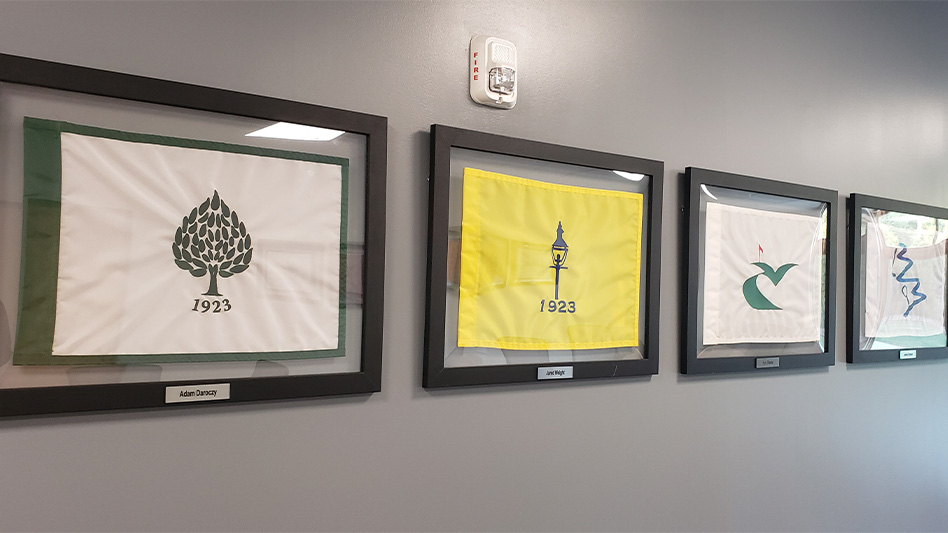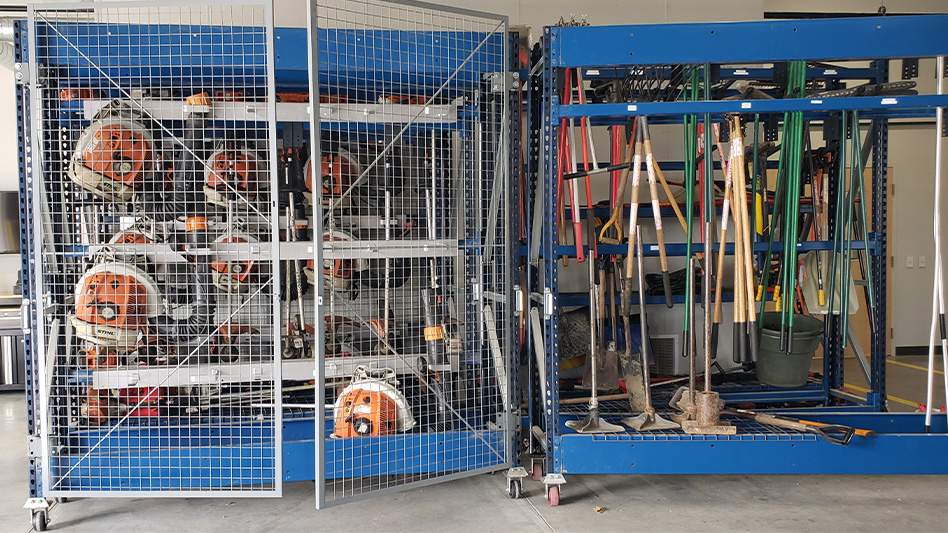
Matt LaWell (3)
A dozen flags line the walls of the Legacy conference room inside the new maintenance facility at Muirfield Village Golf Club, all but one of them mailed back to Dublin, Ohio, by former assistant superintendents now running their own turf shows somewhere else.
This is just one of the dozens of little details Chad Mark designed into the building, which opened in advance of the 2023 season. The facility was nowhere near the top priority for Mark when he was hired in February 2017 to follow Paul B. Latshaw as director of grounds operation, but the need became more obvious during his first seasons back in central Ohio.
Inspired by his run at Sand Ridge Golf Club, a course he helped build and grow in during the middle of his studies at Ohio State, Mark purchased a handful of apps and designed most of the Muirfield Village facility himself on his iPad. He asked experts for help on how much space to save for water and HVAC needs, but almost everything else was laid out on his tablet with an eye on accommodating increased numbers each June during The Memorial Tournament.
For instance, Mark no longer needs to rent a tent to accommodate the team and volunteers for meals throughout tournament week, eliminating what normally checks in as a $30,000 line item. Instead, almost 100 people can filter in from a side lot through garage doors into a large break room. Likewise, the lounge is larger than what might be needed for the 20 to 23 fulltime and 50 to 55 seasonal team members, but it’s perfect for that packed summer week. Same for the bathrooms: The men’s room has expanded from one urinal and one stall to two urinals, four stalls, two showers and a locker room. And there’s a separate dedicated women’s room — a necessity for a staff that includes six women.
Everyday maintenance received just as much attention: The equipment bay, which Mark described as “the lifeblood of everything out there,” measures about 3,500 square feet — almost four times as large as the old 850-square-foot bay. And the new plant protectant building is entirely self-contained, so “nothing can get out,” Mark says. The building doesn’t even include sprinklers, because that would require oxidizers, “and you can’t take the chance you’re going to put water on something that will become an issue.”
In all, the new two-building facility measures about 26,000 square feet. The old facility was 15,000.
“I never really fully gave enough credit to the fact that morale was going to change with the new facility,” Mark says. “And it has. A lot.”
The new facility helps the Muirfield Village team work more efficiently, but there’s more to a successful operation than fancy new digs.
 Among the responsibilities for former Muirfield Village Golf Club assistant superintendents after moving on from Dublin? Mailing back a flag from their new club.
Among the responsibilities for former Muirfield Village Golf Club assistant superintendents after moving on from Dublin? Mailing back a flag from their new club.
The system
Mark has worked nearly 30 years in golf course maintenance, the last 20 as a superintendent or director at Kirtland Country Club, Inverness Club and Muirfield Village. He has never hired an outside assistant superintendent.
“I’m a big believer that my toughest recruiting right now is to get those young, hungry graduates out of school through the system,” he says. “We work really hard to get great interns and to get them to have a great experience that will help them with their career. Some of them we want to have back as full-time employees. They’ll work their way up the system, get to the assistant level, then move on and get their own gig. I think we’re able to recruit at that level because we’ve had so much movement here.
“I have several assistants right now. I know who the next superintendent is.”
Mark places priority on understanding expectations and knowing what the finished product should look like — not just for daily maintenance, but from one week and month and season to the next.
“When you take over a new job or hire a new assistant, it’s important that they know what the finish line looks like,” he says. “You can talk all day about, ‘This is our culture, this is our goal,’ but if you don’t have anybody in the room who understands how to get there, it’s hard to get there. They know where we’re going, they’ve been there, they know the lingo, they know the expectations, they know the system, and that’s why I think it’s been successful.”
How does Mark get the right people on the grounds and, eventually, on the course? He recruits interns from turf schools — he headed to a Penn State job fair in early October — which was not the norm when he was studying at Ohio State. He will also occasionally hire AITs out of college who have not interned at Muirfield Village.
“We’re going to look at their pedigree and where they’ve worked, what kind of operations they’ve been a part of, because this can be daunting, especially for people who start in the spring,” he says. “We’re going to ask them questions about what they liked and disliked about their last position. That’s always a challenging one because they don’t want to go to the negative — but you want to see what their negatives might have been because when you hire them, you’d like to eliminate certain things early on and not overwhelm them if there were things they didn’t like at their last position.”
A different path
There are, of course, far fewer turf students today than a decade or two or three ago, which broadens the potential number of paths for young turf pros to become superintendents.
“When I was coming through Ohio State, you felt like the only way you were going to be a superintendent was to go to Ohio State or Michigan State or Penn State or Rutgers,” Mark says. “Now there are other avenues. … We have a student right now who’s very smart, going to dental school, and he toyed with the idea this summer, ‘If I want to do turf, what would I need to do to do turf?’ For somebody who has a career path like that, for him to even consider turf means we’re doing something right.”
Two of Mark’s three sons have worked on the maintenance team. His oldest, Drew, 19, is studying business at Capital (Ohio) University and is interested in extending the Mark family turf legacy into its third generation.
“I’ve told him it’s great,” Mark says. “Do your business degree — Capital doesn’t have a turf degree, so he can minor in environmental science or something similar — and get the right experience, maybe add a certificate when he’s done, and he’ll be fine in this business. I think the business side of things, when you get to my position at some point, you’re going to have more business decisions — budgeting, communications, HR management — than you are turf decisions. The successful superintendents I see run it like a business.”
 Mark designed most of the club's new maintenance facility on his iPad, and carved out space for rolling, lockable equipment cabinets.
Mark designed most of the club's new maintenance facility on his iPad, and carved out space for rolling, lockable equipment cabinets.
When can you work?
College students aren’t the only folks Mark is recruiting to work on the course. High school students — and especially high school athletes — still fill up plenty of seasonal slots. But practices seem to be more prevalent and less predictable. Also, teenagers still want to have some fun.
“We work around a lot of their schedules,” Mark says. “That’s the only way we can still hire athletes. If you can work till 11 o’clock three days a week, we’ll take you. If you can come in at noon and work till 5, it’ll still help us.”
Mark has embraced shifts. “Does the pro shop staff have the same people close and open?” he asks rhetorically. “No. Does the wait staff that worked lunch work dinner? No. Why wouldn’t we have shifts too? I think it’s a good business model.”
Throughout the spring, some high school students will start their shift at Muirfield Village around 3:30 p.m. or 4 p.m. and work till 7 p.m. One manager stays with them to ensure every job is being done properly. “It eliminated a list of tasks that might have to be accomplished the next morning, and it really took the weight off, especially during shoulder season,” Mark says. “Some of those jobs are better done dry anyhow. If you’re mowing rough or weed eating trees or filling divots, it’s all done better when the turf’s dry.”
The afternoon shift is called The Power Play. Credit to former assistant superintendent James Bryson for the terminology. He’s now the superintendent at The Bedens Brook Club in Skillman, New Jersey.
His flag is framed in the Legacy conference room.
Matt LaWell is Golf Course Industry’s managing editor.
Latest from Golf Course Industry
- Golf Construction Conversations: Stephen Hope
- EnP welcomes new sales manager
- DLF opening centers in Oregon, Ontario
- Buffalo Turbine unveils battery-powered debris blower
- Beyond the Page 66: Keep looking up
- SePRO hires new technical specialist
- Plant Fitness adds Florida partner
- LOKSAND opens North American office





